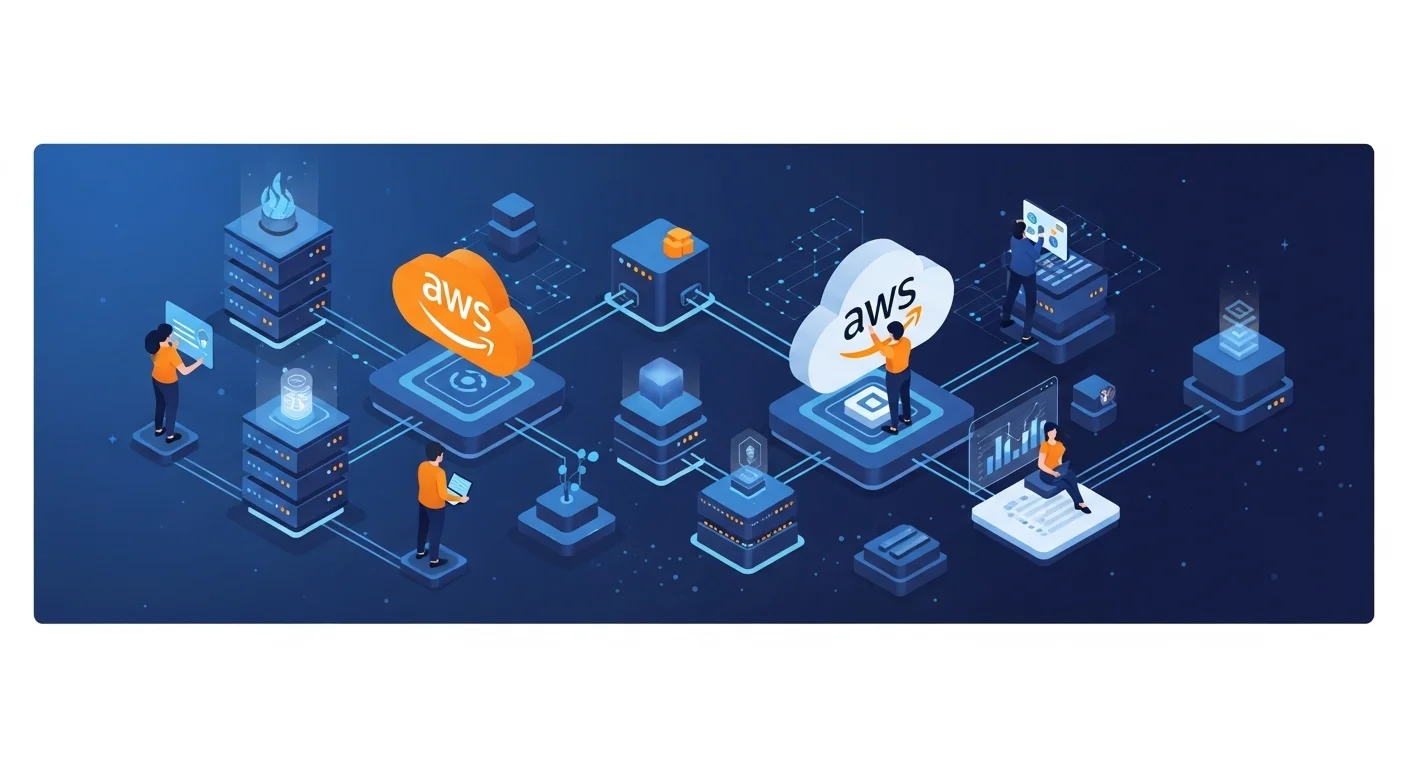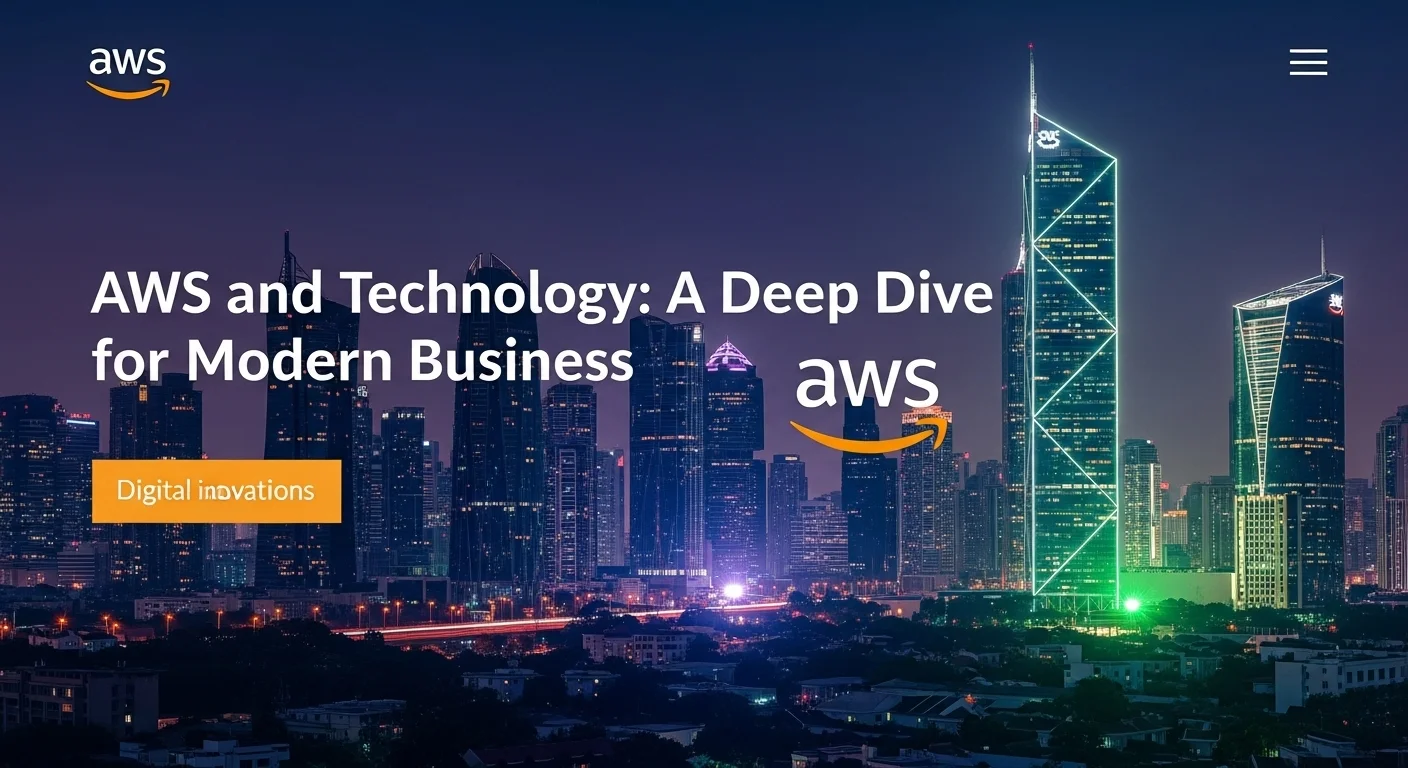AWS Explained: A Practical Guide to Using Amazon's Cloud for Business Growth

Executive Summary
When I first dove into cloud computing years ago, the sheer scale of Amazon Web Services (AWS) was overwhelming. With over 200 services, it felt like trying to drink from a firehose. Where do you even begin? That's exactly why I've put together this guide. It’s for the business leaders, startup founders, and tech professionals who want to understand what AWS can do for them without getting lost in the technical jargon. Together, we'll walk through the essentials: setting up reliable hosting for your applications, exploring the real power of artificial intelligence, locking down your security, and, most importantly, keeping your costs under control. My goal is to give you a clear roadmap for using AWS to make your business faster, smarter, and more innovative.
Table of Contents
Table of Contents
- What is AWS and Why Does It Matter?
- The Core Pillars: Cloud Hosting on AWS
- Driving Innovation with AWS's AI Tools
- Securing Your Cloud: Understanding AWS Cybersecurity
- Specialized Tools and Managing Costs
What is AWS and why is it important in Technology?
In the world of technology, Amazon Web Services (AWS) is a giant. It's the most widely used cloud platform, acting as the digital backbone for millions of businesses, from nimble startups to massive global corporations. But what does that really mean? At its heart, AWS is like a massive, global utility company for computing power. Instead of buying and managing your own physical servers, you can rent computing power, database storage, content delivery, and countless other services from Amazon. The game-changer here is the 'pay-as-you-go' model. Gone are the days of spending a fortune on hardware that might sit idle. With AWS, you only pay for what you use, which has allowed companies to slash IT costs, become incredibly agile, and innovate at a speed we've never seen before. Its importance comes from the sheer variety of tools it offers. Think of it as a digital Swiss Army knife for any IT need. Whether you need to host a website, store vast amounts of data, analyze information with AI, or deliver videos to a global audience, AWS has a specialized tool for the job. It offers Infrastructure as a Service (IaaS), Platform as a Service (PaaS), and Software as a Service (SaaS), which simply means it can handle everything from the basic building blocks to fully-formed applications.
The Core Pillars: Cloud Hosting on AWS
The foundation of AWS is its incredibly robust cloud hosting options. These are the fundamental tools you'll use to build anything online. The most famous is Amazon Elastic Compute Cloud (EC2), which is essentially a virtual server in the cloud. I've used EC2 for everything from tiny blogs to massive e-commerce platforms. The beauty is its flexibility; you can choose the exact amount of processing power, memory, and graphics capability you need, ensuring you're not paying for resources you don't use. Paired with EC2 is Amazon Simple Storage Service (S3), which is like an infinitely scalable hard drive in the cloud. It’s built for durability and can store any amount of data, making it perfect for website images, data backups, or housing massive datasets for analysis. For those who want a simpler experience, I often recommend Amazon Lightsail. It bundles everything you need to launch a server—the virtual machine, storage, networking, and a static IP—into one simple, predictable monthly price. The real magic of AWS hosting is its ability to scale automatically. Using a feature called Auto Scaling, your application can handle sudden traffic spikes—like during a product launch or a viral marketing campaign—without you lifting a finger. It just adds more capacity when needed and scales back down when the traffic subsides, saving you money.
Driving Innovation with AWS's AI Tools
Beyond simple hosting, AWS is a powerhouse in artificial intelligence. What I love is that its AI services are designed to be accessible to everyone, not just data scientists with PhDs. These tools are built on the same technology that drives Amazon's own complex operations. A key service here is Amazon SageMaker, a complete platform that simplifies the machine learning process from start to finish. It helps you prepare data, build and train your models, and then deploy them into a live environment. However, many businesses I work with get incredible value without ever building a model from scratch. AWS offers a suite of pre-trained AI services that you can plug directly into your applications. For instance, Amazon Rekognition can analyze images and videos to detect objects, text, or even sentiment. Amazon Polly can turn text into incredibly lifelike speech, and Amazon Transcribe can convert audio into accurate text. More recently, with the generative AI boom, services like Amazon Bedrock have become invaluable. It gives you easy access to powerful AI models from leading companies, letting you build generative AI applications for creating text, images, or code with relative ease. These AI tools are genuinely transforming industries by enabling things like hyper-personalized customer experiences and automating complex business processes.
Securing Your Cloud: The Imperative of AWS Cybersecurity
In today's digital age, security is non-negotiable. The approach to cybersecurity on AWS is based on a 'Shared Responsibility Model.' In simple terms, AWS takes care of securing the cloud itself—the physical data centers, the hardware, the networking. You, the customer, are responsible for securing what you put *in* the cloud—your data, your applications, and how you manage access. To help you with your side of the bargain, AWS provides a vast arsenal of security tools. The starting point is always AWS Identity and Access Management (IAM). This is your gatekeeper, allowing you to control precisely who can access what. A rule I live by is the 'principle of least privilege'—only give users the bare minimum permissions they need to do their job. For network protection, Amazon Virtual Private Cloud (VPC) lets you carve out your own private, isolated section of the cloud. This gives you complete control over your network environment, almost like having your own private data center. Services like Amazon GuardDuty act as an intelligent security guard, constantly monitoring for suspicious activity, while AWS Shield protects you from common web attacks like DDoS. By layering these tools, you can build a formidable security posture to protect your valuable assets.
Specialized Solutions and Cost Considerations
AWS also shines in providing clever solutions for specific business needs, a great example being the AWS WorkSpaces Thin Client. In an era of remote work, managing hundreds of employee laptops can be a costly and insecure nightmare. This device is a small, cheap, and secure piece of hardware that connects users to their virtual desktops in the cloud. Because no data is stored on the device itself and it runs a locked-down operating system, it dramatically improves security and simplifies life for IT admins. It’s a brilliant solution for roles in call centers, data entry, or for part-time staff. Of course, the big question is always about cost. Understanding the price of AWS hosting is key. The pay-as-you-go model is fantastic for flexibility, but costs can spiral if you're not careful. To manage this, AWS provides great tools. The AWS Free Tier is a fantastic way to experiment without financial risk. For predictable workloads, you can save a huge amount—often over 70%—by committing to usage with Savings Plans or Reserved Instances. Tools like the AWS Pricing Calculator and AWS Cost Explorer give you the visibility you need to track spending, spot trends, and find opportunities to save. By being strategic, you can ensure your cloud costs are lean and efficient, making AWS a powerful engine for growth and innovation.

A Complete Guide to AWS in Technology and Business Solutions
So, you're ready to move beyond the basics and truly master the AWS ecosystem. From my experience, success with AWS comes from a strategic approach that blends technical know-how with smart business practices. This section is a practical guide to doing just that. We’ll roll up our sleeves and get into the specifics of managing your infrastructure, optimizing every dollar you spend, implementing powerful AI, and securing your digital environment. Let's start building robust, efficient, and innovative solutions on the AWS platform.
Technical Deep Dive into AWS Hosting Services
At the core of any cloud deployment are the hosting services on AWS, but using them effectively requires understanding the details. Let's talk about Amazon EC2. It's more than just a virtual server; it's a choice. You start by picking an Amazon Machine Image (AMI), which is a pre-configured template with an operating system and software. Then, you choose an instance type. For example, I often use T-series instances for development sites because they're cheap and can 'burst' to handle occasional traffic spikes. For a balanced application, M-series are great, while C-series are perfect for heavy-duty processing. Your instance's storage is usually an Amazon Elastic Block Store (EBS) volume. Here too, you have choices, from general-purpose SSDs to high-performance volumes for critical databases. A key technique for resilience I always implement is deploying instances across multiple Availability Zones (AZs). Think of an AZ as a separate data center in the same city. If one has a problem, your application stays online because an Elastic Load Balancer automatically redirects traffic to the healthy instances in the other AZ. For websites, a classic and highly effective pattern is to host static assets (like images and CSS) on Amazon S3 and deliver them globally with Amazon CloudFront, the AWS Content Delivery Network (CDN). This setup is incredibly fast for users and surprisingly cheap. AWS Amplify takes this even further for modern web apps by automating the entire deployment pipeline from your code repository.
Mastering the Cost of AWS Hosting
A common fear I hear from clients is the 'surprise' cloud bill. Managing the cost of hosting on AWS is an ongoing discipline, not a one-time task. Visibility is the first step. I spend a lot of time in AWS Cost Explorer; it's a fantastic tool for slicing and dicing your spending data to see exactly where the money is going. To be proactive, you absolutely must set up AWS Budgets. You can create alerts that notify you when costs are projected to exceed your threshold, preventing month-end shocks. Beyond monitoring, 'rightsizing' is crucial. This is the art of matching your resources to your actual needs. AWS Compute Optimizer is your friend here; it analyzes your usage and recommends more cost-effective instance types. For predictable workloads, using Savings Plans or Reserved Instances is a no-brainer. They offer massive discounts in exchange for a one or three-year commitment. Savings Plans are more flexible, applying to different instance types, while Reserved Instances are for specific ones. And for tasks that can be interrupted, like data processing jobs, I always use EC2 Spot Instances. They let you bid on unused capacity, often saving up to 90%. They can be terminated with two minutes' notice, but for the right workload, the savings are incredible. Finally, a disciplined tagging strategy is non-negotiable. Tagging every resource with its project, team, or owner lets you allocate costs accurately and understand your spending at a granular level.
Implementing Advanced AWS AI Solutions
Bringing AWS's AI tools into your business can be a game-changer, and you don't need a team of data scientists to start. AWS smartly tiers its services for different skill levels. For quick wins, the pre-trained AI services are fantastic. Imagine a customer service chatbot. You can build a sophisticated one using Amazon Lex (the engine behind Alexa), give it a natural voice with Amazon Polly, and even make it multilingual with Amazon Translate. To analyze customer feedback from social media, Amazon Comprehend can perform sentiment analysis and extract key phrases, giving you instant insights. For teams that want to build their own custom models, Amazon SageMaker is the complete package. It provides an integrated environment where you can prepare data, train a model using powerful infrastructure, and deploy it with a single click. The rise of generative AI has made Amazon Bedrock one of the most exciting services right now. It provides a simple API to access powerful foundation models from various AI leaders. This allows businesses to experiment with generating text, code, or images to find the perfect fit for their needs, all without managing the underlying infrastructure. It's truly democratizing access to cutting-edge AI.
A Practical Guide to AWS Cyber and the AWS Workspaces Thin Client
A secure cloud environment is built in layers. A practical approach to cybersecurity on AWS starts with IAM best practices: never use your root account for daily tasks, enforce Multi-Factor Authentication (MFA) everywhere, and be strict with permissions. For your network, use a combination of Security Groups (a firewall for your instances) and Network Access Control Lists (a firewall for your subnets) to control traffic. Data protection is paramount. Always encrypt your data, both in transit (with TLS) and at rest. AWS Key Management Service (KMS) makes it easy to manage the encryption keys. Also, enable AWS CloudTrail to log all API activity; it’s your account's security camera. In the context of remote work, the AWS Workspaces Thin Client is a brilliant security tool. Laptops in the wild are a huge risk, with company data stored locally on devices connecting from unsecured networks. The thin client solves this by keeping all data and applications in the cloud. The device itself is locked down, preventing users from installing unauthorized software. From a business standpoint, the deployment is incredibly smooth. You can order them and have them shipped directly to employees, who can set them up in minutes without IT help. Management is centralized, allowing IT to monitor and control devices from a single console. It's a solution that not only tightens security but also lowers the overall cost of supporting a remote workforce.

Tips and Strategies for AWS to Improve Your Technology Experience
Getting the most out of Amazon Web Services isn't just about using its services—it's about using them smartly. Over the years, I've seen that a focus on continuous optimization, proactive security, and intelligent adoption of new tools is what separates the good from the great. This section is all about actionable tips and strategies that can elevate your AWS experience. By implementing these practices, you can build an environment that's not only cost-effective and secure but also a powerful engine for innovation.
Advanced Strategies for Optimizing the Cost of AWS Hosting
Managing the cost of hosting on AWS is an ongoing hunt for efficiency. Here are some advanced strategies I use. First, automate your resource schedules aggressively. Most development and test environments don't need to run 24/7. Use the AWS Instance Scheduler or a simple Lambda function to automatically shut them down overnight and on weekends. This simple trick can cut their costs by over 70%. Second, be ruthless with your storage optimization. For Amazon S3, use S3 Storage Lens to get a clear picture of your storage patterns. Then, turn on S3 Intelligent-Tiering. This service is magical; it automatically moves your data between access tiers to save you money without you having to do anything. For long-term archival, create lifecycle policies to move old data to S3 Glacier or Deep Archive for pennies on the dollar. Third, foster a FinOps culture. This means getting your finance, tech, and business teams talking to each other about cloud spending. Use tools like AWS Cost Anomaly Detection, which uses machine learning to flag weird spending spikes so you can investigate immediately. Also, make the AWS Trusted Advisor your best friend. Its Cost Optimization checks are like having a free consultant point out idle resources and underutilized instances, giving you a clear to-do list for saving money.
Proactive AWS Cyber Security Best Practices
A proactive, layered approach to cybersecurity on AWS is the only way to stay ahead of threats. Here are some pro tips. First, automate your security responses. Use AWS Config to monitor your resource configurations for compliance. If a resource becomes non-compliant—say, an S3 bucket is made public—you can trigger an automatic fix with a Lambda function. This is how you remediate issues in seconds, not days. Second, 'shift left' with your vulnerability management. Integrate AWS Inspector into your CI/CD pipeline to scan your code and container images *before* they get deployed. Catching a vulnerability in development is a thousand times better than finding it in production. For a bird's-eye view, use AWS Security Hub. It pulls in findings from GuardDuty, Inspector, and other services into a single dashboard, prioritizing the most critical alerts for you. Third, get serious about data discovery. Use Amazon Macie to automatically find and protect sensitive data in S3, like personal information or financial records. It will alert you to where your sensitive data lives and how it's being accessed. And a simple but critical practice: rotate your access keys and credentials regularly. Compromised keys are a common entry point for attackers.
Strategic Implementation of AWS AI and Business Tools
To get real value from AWS AI, you need a strategy. My advice is always to start with a clear business problem, not the technology. Instead of a vague goal like 'we should use AI,' define a specific objective like 'we need to reduce customer support response times by 30%.' With a clear goal, you can pick the right tool. For that example, you might use Amazon Lex to build a chatbot to handle common queries instantly. Another powerful strategy is to use AI to augment your team, not replace them. For a marketing team, Amazon Bedrock can generate first drafts of blog posts or ad copy, which a human can then perfect. This drastically cuts down content creation time. To empower your team, use AWS's own training resources like AWS Skill Builder, which offers hundreds of free courses. For staying on top of tech trends, I always recommend the MIT Technology Review as a fantastic external resource. When you look at business tools, think about integrated solutions. Amazon Connect, for example, is a complete cloud contact center you can set up in minutes. You can then supercharge it with AI: use Lex for chatbots, Polly for natural voice interactions, and Contact Lens to analyze call sentiment in real-time. That's how you turn a simple tool into a powerful business intelligence platform.
Enhancing the Remote Work Experience with AWS Workspaces Thin Client
In our new world of remote work, providing a secure and productive user experience is a huge challenge. The AWS Workspaces Thin Client is a strategic solution. To get the most out of it, identify the right user groups. It's perfect for roles that are primarily cloud-based and don't need a powerful local machine—think contact center agents, administrative staff, or contractors. This targeting gives you the biggest bang for your buck in cost savings and security. Second, nail the onboarding process. Even though the device is simple to set up, create a short, friendly video guide for your employees. As you can see in AWS's own demos, a user can go from unboxing to working in just a few minutes. A smooth start prevents frustration and helpdesk tickets. For IT, the key is mastering the centralized management console. You can set different policies for different user groups, like enforcing stricter update schedules for teams handling sensitive data. Finally, this isn't just a hardware strategy; it's a security strategy. Ensure the virtual desktop environments these clients connect to (like Amazon WorkSpaces) are themselves secure, with proper network controls and IAM policies. By treating the thin client as part of your holistic, cloud-first security posture, you create a seamless and highly secure experience for your entire remote workforce.
Expert Reviews & Testimonials
Sarah Johnson, Business Owner ⭐⭐⭐
The information on AWS is solid, but as a business owner, I would have loved a few more real-world case studies to see how these tools solve common problems.
Mike Chen, IT Consultant ⭐⭐⭐⭐
Great overview of AWS. It clarified a lot for me as a consultant, though a simpler breakdown of the pricing models would have been the cherry on top.
Emma Davis, Tech Expert ⭐⭐⭐⭐⭐
An outstanding and comprehensive article on AWS! It was incredibly helpful for my specialization. Everything was explained clearly and was easy to follow. A must-read!



